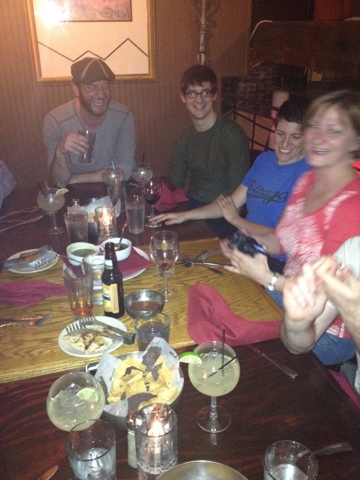With all the talk about the new downtown Franklin
hotel in the works, I thought this would be a good time to review the various
hotels, motels, inns and boarding houses from Franklin’s history.
All towns of any size had lodging for visitors. When
you consider a trip from Nashville to Franklin by horseback took the better
part of a day, you had to find overnight accommodations.
Franklin’s first inn was built in 1803 by Benjamin
White on Bridge Street. The two-story frame building stood until it was torn
down in 1905. By then it was no longer an inn.
Another inn stood on the square at the location of the
current Fifth Third Bank. By 1888 the building was in such disrepair that it
was demolished.
During the process, a gruesome discovery in the
basement caused the police and citizens to scratch their collective head in
puzzlement.
After the tear down work was finished, the workers
then needed to assure the foundation was sufficiently sturdy to build the two-story
brick building that stands there today. As they were walking around the
basement floor, someone noticed a spongy spot. They wondered if it was a well,
or something else they couldn’t imagine, but whatever, they dug down into the
soft spot.
First they uncovered a couple feet’s worth of trash
and debris. Then came a layer of lime. Hmmm….lime, and not the kind that comes with your Corona. This was
quicklime, a chemical compound that, among other things, is used to mask
unpleasant odors. Sooooo….that raised suspicions. Keep digging, fellas!
Under the layer of lime, they found something shocking.
Bones, the remains of a man. From the looks of it, he’d been down there a long,
long time. Obviously, as they say, foul play was indicated.
That basement was
never used as a cemetery.
The police had no idea who it might be. So they asked
for the assistance of the community, asking townspeople to think back and see
if they could remember anything that might shed some light on the body in the
basement.
Finally, one of the oldest men in town came forward.
He remembered something from the distant past he thought might relate to the
dead man. We’ll call him Abner (because we don’t know his name).
Abner thought it was about 1825 that a peculiar stranger
came to town and stayed at the inn. He remembered that the man stayed aloof and
standoffish from the town. Franklin was tiny then and as a resident, you’d
naturally want to know who was visiting, but this stranger told them nothing
about himself. The stranger stayed at the inn for two weeks. One morning, he
wasn’t around. When asked, the innkeeper said the stranger had disappeared in
the night, and furthermore, stiffed him on his bill. Everybody commiserated
with the innkeeper,
and the man never came back.
About a year later an old man came to town looking for
his daughter and the man she’d eloped with. It also came out that they’d stolen
some money. The father had tracked the man to Franklin (Abner didn’t know
anything about a woman; the thief must have already ditched her). Back then, if
someone disappeared or ran off, and you wanted to find them, you had to go
looking, following the trail.
When he described the man, everyone in town said he
looked like that man from the year before. That is, everybody but the innkeeper,
who gave a totally different description. Abner said folks thought that was
odd, because they all said they clearly remembered what he looked like, and
also, the timing was right on the man being here. Nevertheless, the trail ended.
The old man went sadly away, the search for his daughter (and his money,
although not necessarily in that order) having ended in Franklin. Where he went
next, we do not know.
A year later, the innkeeper sold the inn. To
everyone’s surprise, he bought and moved to a big plantation in Mississippi.
Abner said no one could believe that he’d made the kind of money it took to buy
that property. Six months later the town got the sad news that he’d hanged
himself from the rafters of his barn. What?!
They couldn’t believe it. It seemed as if he’d done so well for himself. Why
would he kill himself?
No one thought about it again until 60 years later
with the discovery of the body in the basement.
The pieces of the puzzle finally fit.
The innkeeper killed the stranger for his money and
buried his body in the basement. He waited, knowing if anyone was missing that
man, they might come looking for him. Sure enough, a year later, someone showed
up just for that reason. The innkeeper denied ever having seen the man (although
everyone else in town said they remembered him) and threw the searcher off the
trail.
The innkeeper continued to wait it out, just to be safe.
A year later he took the money he stole and bought the land in Mississippi.
Then…well, we suspect his conscience got to him and that’s why he killed
himself. Although I am reminded of Poe’s classic The Tell-tale Heart…Da-dum,
da-dum. Three years of that might just have driven him mad (I hope that’s
what happened anyway). I suppose he thought the torture of a guilty conscience would
end when he moved away. And I suppose it didn’t.
And the only reason we know the truth of what happened
is because they found the body in the basement 60 years later. Which makes me wonder, how many others bodies are buried in some of the basements around here?
How many murders have gone undetected because a person just “disappeared.” Hmmm…makes you think, doesn’t it?
Think about that the next time you check into a hotel.
This article first appeared in May's YOUR Williamson.







































